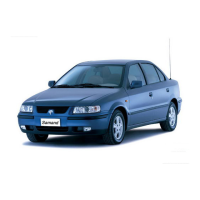19
Samand
Technical description
Crash and Safety
Long high performance energy absorbing rear and front parts and an effective side structure complete the role of body
design in crashworthiness.
To ensure that no change or deterioration in the performance and characteristics of the car occurs after a bodywork
repair it is extremely important for repair work to be carried out correctly using the proper materials.
Safety
Automotive crashworthiness is defined as the capability of a vehicle to provide adequate protection for its occupants in
the events of collision. In X7, utilising wisely a combination of high performance energy absorbing front and rear
structures with well-tuned restraint systems, make its passenger cage a reliable survival area.
Induced frontal impact forces are gradually dissipated through two main paths where around 60% of the total loads
transfer by means of side-rail assembly. Having created plastic zones in pre-designed buckling locations, the crash
kinetic energy is greatly reduced by its way through these paths. The direct result for the passengers will be a
moderate crash pulse, which minimise their injuries. The remaining forces will be distributed as uniformly as possible
among sills and the two straight members underneath of the floor panel.
In the event of side crashes, the severity of injuries is completely dependant on body side geometrical and mechanical
specifications. To lower the risk of injuries, X7 side structure is designed to resist an acceptable level of imposed loads,
while deformation pattern is appropriate in B-pillar. Thanks to the robust design of the side structure, door side impact
beams and passengers driving position, the X7 is armed with a safe cage against any accident that has a catastrophic
lateral loading.
Caution
In order for IKCO to be able to accept responsibility and guarantee continued crash safety after repairs, it is essential
the body-work is carried out in the correct manner and with correct materials.

